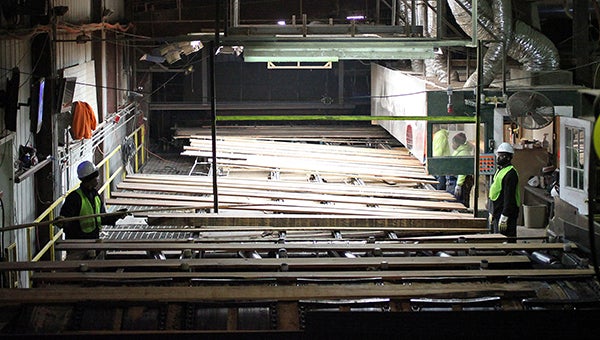INVASION IMMINENT: Emerald ash borer would hurt forestry economy
Published 12:00 am Sunday, July 26, 2015

HARDWOOD INSPECTION: Employees inspect boards before they are sent out of the sawmill at Anderson-Tully Lumber Company.
The outlook for ash trees in Mississippi is grim as a metallic green beetle makes its way southward.
The emerald ash borer — referred to in forestry and entomology as EAB — has been identified in 25 states, devastating production of ash and some related trees. Mississippi and Alabama are virtually surrounded with infected forest, and it seems less a matter of if than when the most destructive forest pest ever seen on this continent invades here, Mississippi State University forestry professor John Willis told the Warren County Forestry Association.
“The latest state is Louisiana, and it has marched over and is on its way to Mississippi as we speak, probably,” Willis said. “Will the EAB reach Mississippi? I can’t tell you yes. I can’t tell you no. I can’t tell you when. It could be today. It could be in 10 years. There’s really no predicting it. But there are a couple things we have that indicate it’s highly likely.”
States with emerald ash borer infestations have quarantined areas where the insects are known, but all containment efforts have failed, mostly because damage to trees begins showing years after the pests have arrived.
“What most people see first is crown loss. It will typically occur in two to five years after the insect has left. That’s incredibly important. It will take two to five years for you to even notice it, and by then the damage is done,” Willis said.
Quarantines halt the movement of all ash products — timber, firewood, pallets, etc. — outside the specific zone during what is referred to as flight season when the bugs are most active. Some states have quarantined counties, while others have placed statewide bans on moving ash.
“It’s on the way to becoming the most economically costly insect to be introduced to the United States. I’m not grandstanding on this one. It’s just been bad. We just don’t have any tools to deal with it on a large scale,” Willis said.
With an all but impending infestation, foresters are facing the dilemma of treating trees with pesticides in advance, harvesting immature ash to sell the timber on a flooded market or just waiting in hope of a full harvest.
“I don’t have a definitive answer for you,” Willis said.
Anderson-Tully officials have said a quarantine and damage caused by beetle could hurt production at its Vicksburg sawmill. ATCO forester Norman Davis describes the tree as “a very important, valuable species.”
“It’s a very serious issue,” Davis said.
In Warren County, timber production generates about 1,600 jobs every year in an industry that has a total output of about $340 million, according to the Mississippi State Extension Service. Extension officials estimate about 7.3 percent of the Warren County economy is derived from forestry and forest products.
More than a quarter million acres — 97 percent of the county’s total forest — is planted in hardwoods including ash. Ash represents about 5 percent of all hardwood about 20 percent of the hardwood market, Extension Agent John Coccaro said.
Ash is also a popular landscaping tree. Vicksburg landscape director Jeff Richardson said there are ash trees planted throughout Vicksburg but not as many as in north cities where the borer has killed tens of millions of trees.
“It’s very few trees,” Richardson said.
No one is exactly sure how the ash borer will perform in the Mississippi climate, though Warren County is in the northernmost area the USDA estimates the beetle might be active and reproduce year-round. In its native China and in northern states, the emerald ash borer spawns once a year. Here it might be able to produce several generations a year.
“We don’t really know how it’s going to react down here,” Willis said.
In March, evidence was discovered that the ash borer had switched hosts and began targeting the white fringe tree. There’s no evidence it has targeted any other hardwoods though lilac and several others are in the same family as ash.
“This is probably the most alarming thing we’ve seen with EAB,” Willis said.
The Chinese beetle is a relatively slow moving insect. The most remarkable borers can only travel five miles per year, and most only travel a few hundred feet.
But as with many other invasive species, humans have expedited and complicated dispersal patterns.
“We all know how much freight moves down the Mississippi. All it’s going to take is one EAB larvae getting away on a pallet, and we’ve got it,” Willis said.
Scientists have released parasitic wasps that are a natural predator of the beetles but results in North America haven’t been studied long enough to determine effectiveness.
Researchers in Connecticut recently said it’s likely to be 10 to 15 years before they can definitely determine whether the two types of Chinese wasps involved will be able to keep the ash tree-killing beetles in check.
Willis said he has doubts about the wasps.
“The time to do something is now, and it’s probably actually yesterday,” Willis said.





